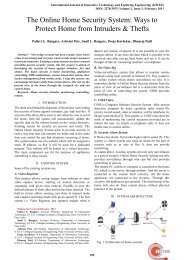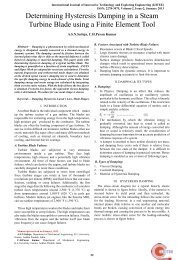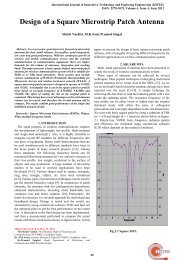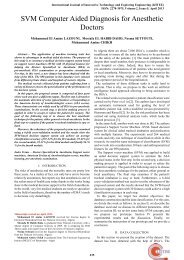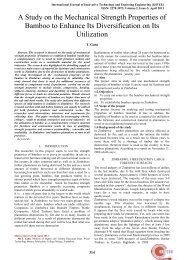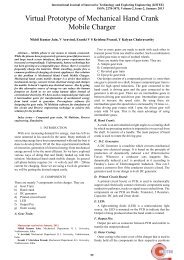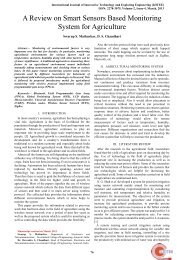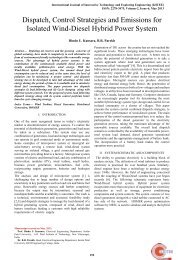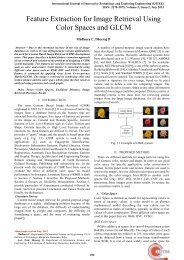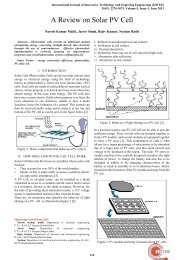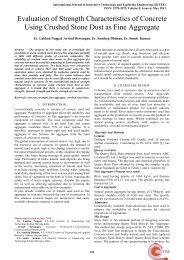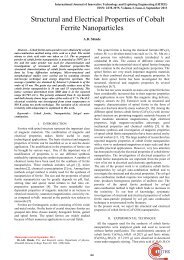Effect of Pressure Angle on Transmission Efficiency of Helical Gears
Effect of Pressure Angle on Transmission Efficiency of Helical Gears
Effect of Pressure Angle on Transmission Efficiency of Helical Gears
Create successful ePaper yourself
Turn your PDF publications into a flip-book with our unique Google optimized e-Paper software.
Internati<strong>on</strong>al Journal <str<strong>on</strong>g>of</str<strong>on</strong>g> Innovative Technology and Exploring Engineering (IJITEE)<br />
ISSN: 2278-3075, Volume-3, Issue-2, July 2013<br />
<str<strong>on</strong>g>Effect</str<strong>on</strong>g> <str<strong>on</strong>g>of</str<strong>on</strong>g> <str<strong>on</strong>g>Pressure</str<strong>on</strong>g> <str<strong>on</strong>g>Angle</str<strong>on</strong>g> <strong>on</strong> Transmissi<strong>on</strong> <strong>Efficiency</strong><br />
<str<strong>on</strong>g>of</str<strong>on</strong>g> <strong>Helical</strong> <strong>Gears</strong><br />
Pande A. M., Kharde Y. R.<br />
Abstract:- In this study, a test methodology for measuring<br />
load-dependent (mechanical) power losses <str<strong>on</strong>g>of</str<strong>on</strong>g> helical gear pairs is<br />
developed. A high-speed four-square type test machine is adapted<br />
for this purpose. Several sets <str<strong>on</strong>g>of</str<strong>on</strong>g> helical gears having 3 different<br />
pressure angles are manufactured, and their power losses under<br />
dip lubricated c<strong>on</strong>diti<strong>on</strong>s are measured at various speed and<br />
torque levels. A general trend found in the experimental testing<br />
was that the higher the pressure angle, the lower the<br />
temperature-increase <str<strong>on</strong>g>of</str<strong>on</strong>g> the lubricant across the gearbox while<br />
being tested at identical c<strong>on</strong>diti<strong>on</strong>s. This is an indicati<strong>on</strong> <str<strong>on</strong>g>of</str<strong>on</strong>g> the<br />
improved efficiency. Finally it was c<strong>on</strong>cluded that high-pressure<br />
angle helical gears (25°) pressure angle running at high speed<br />
provide improved performance over more traditi<strong>on</strong>al gear<br />
pressure angles (20°).<br />
Key Words- load-dependent power losses, helical gear, pressure<br />
angle, efficiency.<br />
I. INTRODUCTION<br />
The looming energy crisis and envir<strong>on</strong>mental c<strong>on</strong>cerns in<br />
regards to global warming and air quality have recently placed<br />
great emphasis <strong>on</strong> fuel ec<strong>on</strong>omy performance and gas and<br />
particulate emissi<strong>on</strong>s <str<strong>on</strong>g>of</str<strong>on</strong>g> passenger and commercial vehicles.<br />
Both emissi<strong>on</strong>s and fuel c<strong>on</strong>sumpti<strong>on</strong> <str<strong>on</strong>g>of</str<strong>on</strong>g> a vehicle are<br />
influenced largely by the efficiency <str<strong>on</strong>g>of</str<strong>on</strong>g> the power train <str<strong>on</strong>g>of</str<strong>on</strong>g> the<br />
vehicle. Power losses <str<strong>on</strong>g>of</str<strong>on</strong>g> a power train can be traced back to<br />
the inherent losses <str<strong>on</strong>g>of</str<strong>on</strong>g> the engine in generating the power and<br />
the losses that occur during transmissi<strong>on</strong> <str<strong>on</strong>g>of</str<strong>on</strong>g> power to the<br />
wheels through the drive train. The transmissi<strong>on</strong> can be<br />
identified as the major comp<strong>on</strong>ent <str<strong>on</strong>g>of</str<strong>on</strong>g> the drive train not <strong>on</strong>ly<br />
in terms <str<strong>on</strong>g>of</str<strong>on</strong>g> its c<strong>on</strong>tributi<strong>on</strong>s to the power losses, but also the<br />
potential it presents for improving overall power train<br />
efficiency.<br />
The power losses c<strong>on</strong>sist <str<strong>on</strong>g>of</str<strong>on</strong>g> speed- and load-dependent<br />
losses. Speed-dependent losses can be divided into windage<br />
losses, churning losses, bearing churning losses and seal<br />
losses. The load-dependent losses are made up <str<strong>on</strong>g>of</str<strong>on</strong>g> sliding<br />
fricti<strong>on</strong> loss, rolling fricti<strong>on</strong> loss and bearing loss. In<br />
automotive applicati<strong>on</strong>s, for instance, geared comp<strong>on</strong>ents <str<strong>on</strong>g>of</str<strong>on</strong>g><br />
systems such as manual transmissi<strong>on</strong>s, transfer cases, and<br />
fr<strong>on</strong>t or rear axles, might rotate at reas<strong>on</strong>ably high speeds<br />
(say, gear pitch-line velocities in excess <str<strong>on</strong>g>of</str<strong>on</strong>g> 20–30 m/s) to<br />
cause significant amounts <str<strong>on</strong>g>of</str<strong>on</strong>g> spin losses. While<br />
load-dependent and spin power losses can be comparable in<br />
magnitude under high-load and lower speed c<strong>on</strong>diti<strong>on</strong>s, the<br />
spin losses typically dominate the load-dependent power<br />
losses at these higher operating speeds.<br />
Manuscript received <strong>on</strong> July 2013.<br />
Pr<str<strong>on</strong>g>of</str<strong>on</strong>g>. Pande A. M., Mech. Engg. Department, Amrutvahini Polytechnic,<br />
Sangamner,India.<br />
Pr<str<strong>on</strong>g>of</str<strong>on</strong>g>. Dr. Kharde Y.R., Principal, Sai Baba Institute <str<strong>on</strong>g>of</str<strong>on</strong>g> Engineering and<br />
Technology, Rahata, Dist- Ahmednagar, Maharashtra,India.<br />
A. Speed Dependant Losses<br />
II. TYPES OF GEAR LOSSES<br />
Windage losses: As gears rotate, lubricant is flung <str<strong>on</strong>g>of</str<strong>on</strong>g>f the<br />
gear teeth in small oil droplets due to the centrifugal force<br />
acting <strong>on</strong> the lubricant. These lubricant droplets create a fine<br />
mist <str<strong>on</strong>g>of</str<strong>on</strong>g> oil that is suspended inside the gear housing/case. The<br />
effect <str<strong>on</strong>g>of</str<strong>on</strong>g> this oil mist is an increase in "windage fricti<strong>on</strong>al<br />
resistance" <strong>on</strong> the gears and hence an increase in the power<br />
c<strong>on</strong>sumpti<strong>on</strong>. In additi<strong>on</strong>, the expulsi<strong>on</strong> <str<strong>on</strong>g>of</str<strong>on</strong>g> the oily<br />
atmosphere from the tooth spaces as the gear teeth come into<br />
engagement creates turbulence within the gearbox and<br />
increases the power c<strong>on</strong>sumpti<strong>on</strong>. The combinati<strong>on</strong> <str<strong>on</strong>g>of</str<strong>on</strong>g> these<br />
factors, as well as the losses at the side faces <str<strong>on</strong>g>of</str<strong>on</strong>g> the gears,<br />
c<strong>on</strong>tribute to the total windage losses. Factors that influence<br />
the magnitude <str<strong>on</strong>g>of</str<strong>on</strong>g> the windage loss include the rotati<strong>on</strong>al speed<br />
<str<strong>on</strong>g>of</str<strong>on</strong>g> the gear because power losses rise with an increase in<br />
peripheral velocity. Other factors arc the tooth module. the<br />
amount <str<strong>on</strong>g>of</str<strong>on</strong>g> oil mist present inside the casing and the diameter<br />
<str<strong>on</strong>g>of</str<strong>on</strong>g> the gears.<br />
Oil Churning Loss:- Churning losses are defined as the<br />
acti<strong>on</strong> <str<strong>on</strong>g>of</str<strong>on</strong>g> the gears moving the lubricant inside the gear case<br />
and referred in particular to the losses due to entrapment <str<strong>on</strong>g>of</str<strong>on</strong>g><br />
the lubricant in the gear mesh, which is more applicable to<br />
spur gears than to helical gears. Factors influencing the oil<br />
churning loss are the viscosity <str<strong>on</strong>g>of</str<strong>on</strong>g> the oil, as this resists the<br />
moti<strong>on</strong> <str<strong>on</strong>g>of</str<strong>on</strong>g> the gears: peripheral velocity: operating<br />
temperature: the tooth module: the helix angle: and the<br />
submerged depth <str<strong>on</strong>g>of</str<strong>on</strong>g> the gears. All rotating comp<strong>on</strong>ents that<br />
are in direct c<strong>on</strong>tact with the lubricant, i.e. dipped into the oil,<br />
c<strong>on</strong>tribute to the churning losses, and the deeper the<br />
comp<strong>on</strong>ents are submerged, the higher the losses. With larger<br />
helix angles, the power losses are lower as the gear teeth slice<br />
through the lubricant rather than displacing the lubricant<br />
al<strong>on</strong>g the whole gear face width.<br />
B. Load Dependant Losses<br />
Sliding Fricti<strong>on</strong> Loss:- Principally, the instantaneous<br />
sliding fricti<strong>on</strong> loss is a functi<strong>on</strong> <str<strong>on</strong>g>of</str<strong>on</strong>g> the instantaneous sliding<br />
velocity and the fricti<strong>on</strong> force, which itself is a functi<strong>on</strong> <str<strong>on</strong>g>of</str<strong>on</strong>g> the<br />
instantaneous normal tooth load and the instantaneous<br />
coefficient <str<strong>on</strong>g>of</str<strong>on</strong>g> fricti<strong>on</strong>, The magnitude <str<strong>on</strong>g>of</str<strong>on</strong>g> sliding velocity<br />
depends <strong>on</strong> the positi<strong>on</strong> <str<strong>on</strong>g>of</str<strong>on</strong>g> c<strong>on</strong>tact al<strong>on</strong>g the c<strong>on</strong>tact path with<br />
a peak velocity at the start <str<strong>on</strong>g>of</str<strong>on</strong>g> the approach. The velocity<br />
reduces to 0 at the pitch point <str<strong>on</strong>g>of</str<strong>on</strong>g> the two mating gears and<br />
rises again to a peak value at the end <str<strong>on</strong>g>of</str<strong>on</strong>g> the recess. The effect<br />
<str<strong>on</strong>g>of</str<strong>on</strong>g> the sliding fricti<strong>on</strong> loss is an increase in power<br />
c<strong>on</strong>sumpti<strong>on</strong>, where the magnitude depends <strong>on</strong> the point <str<strong>on</strong>g>of</str<strong>on</strong>g><br />
c<strong>on</strong>tact. It is influenced by the angular velocity <str<strong>on</strong>g>of</str<strong>on</strong>g> the gears,<br />
the ratio <str<strong>on</strong>g>of</str<strong>on</strong>g> the rolling velocities, the point <str<strong>on</strong>g>of</str<strong>on</strong>g> c<strong>on</strong>tact, the<br />
c<strong>on</strong>tact ratio and the lubricant properties. The sliding fricti<strong>on</strong><br />
loss is dependent <strong>on</strong> the positi<strong>on</strong> <str<strong>on</strong>g>of</str<strong>on</strong>g> c<strong>on</strong>tact during the<br />
engagement cycle.<br />
42
<str<strong>on</strong>g>Effect</str<strong>on</strong>g> <str<strong>on</strong>g>of</str<strong>on</strong>g> <str<strong>on</strong>g>Pressure</str<strong>on</strong>g> <str<strong>on</strong>g>Angle</str<strong>on</strong>g> <strong>on</strong> Transmissi<strong>on</strong> <strong>Efficiency</strong> <str<strong>on</strong>g>of</str<strong>on</strong>g> <strong>Helical</strong> <strong>Gears</strong><br />
Rolling fricti<strong>on</strong> loss:- The rolling fricti<strong>on</strong> loss is<br />
dependent <strong>on</strong> the instantaneous rolling velocity and the<br />
instantaneous lubricant film thickness. As the gear teeth come<br />
into mesh, an elastohydrodynamic lubricant film is developed<br />
between the teeth in c<strong>on</strong>tact. The acti<strong>on</strong> <str<strong>on</strong>g>of</str<strong>on</strong>g> the gear teeth<br />
during the engagement draws the lubricant into the c<strong>on</strong>tact<br />
z<strong>on</strong>e. The parameters that influence the rolling fricti<strong>on</strong> loss<br />
are the lubricant film thickness, the angular velocity <str<strong>on</strong>g>of</str<strong>on</strong>g> the<br />
gears, the working pressure angle and the point <str<strong>on</strong>g>of</str<strong>on</strong>g> c<strong>on</strong>tact<br />
al<strong>on</strong>g its c<strong>on</strong>tact path. The lubricant properties influence the<br />
buildup <str<strong>on</strong>g>of</str<strong>on</strong>g> the lubricant film, its shear values and its thermal<br />
behavior. In additi<strong>on</strong>, the gear material and the normal tooth<br />
load also influence the film thickness.<br />
Spin power losses <str<strong>on</strong>g>of</str<strong>on</strong>g> a gearbox are either due to churning <str<strong>on</strong>g>of</str<strong>on</strong>g><br />
the lubricant if the rotating comp<strong>on</strong>ents <str<strong>on</strong>g>of</str<strong>on</strong>g> the gearbox are<br />
immersed in an oil bath (dip-lubricated) or due to windage if<br />
the lubricati<strong>on</strong> method is jet-type and the surrounding<br />
medium is air or a fine mist <str<strong>on</strong>g>of</str<strong>on</strong>g> air and oil. Focusing <strong>on</strong> the<br />
most fundamental comp<strong>on</strong>ent <str<strong>on</strong>g>of</str<strong>on</strong>g> the gearbox, i.e. a gear pair<br />
in mesh, this chapter aims at developing a novel<br />
physics-based fluid mechanics model <str<strong>on</strong>g>of</str<strong>on</strong>g> oil churning losses<br />
due to interacti<strong>on</strong>s <str<strong>on</strong>g>of</str<strong>on</strong>g> the gears, both as a pair and as<br />
individual entities, with the surrounding lubricant medium.<br />
III. LITERATURE REVIEW<br />
Robert F. Handschuh et al completed a preliminary study<br />
to determine the feasibility <str<strong>on</strong>g>of</str<strong>on</strong>g> using high-pressure angle gears<br />
in aer<strong>on</strong>autic and space applicati<strong>on</strong>s[1]. Y. Michlin et al<br />
described a methodology for analysis <str<strong>on</strong>g>of</str<strong>on</strong>g> gear transmissi<strong>on</strong><br />
with allowances for the power losses due to both the rolling<br />
and sliding fricti<strong>on</strong>. The latter fricti<strong>on</strong>, incorporated in the<br />
traditi<strong>on</strong>al methods, does not by itself account for the wear <str<strong>on</strong>g>of</str<strong>on</strong>g><br />
the teeth at c<strong>on</strong>tact sites adjoining the pitch point, where the<br />
rolling losses are paramount[2]. Xu Hai et al proposed a<br />
computati<strong>on</strong>al model for the predicti<strong>on</strong> <str<strong>on</strong>g>of</str<strong>on</strong>g> fricti<strong>on</strong>-related<br />
mechanical efficiency losses <str<strong>on</strong>g>of</str<strong>on</strong>g> parallel-axis gear pairs. The<br />
model incorporates a gear load distributi<strong>on</strong> model, a fricti<strong>on</strong><br />
model, and a mechanical efficiency formulati<strong>on</strong> to predict the<br />
instantaneous mechanical efficiency <str<strong>on</strong>g>of</str<strong>on</strong>g> a gear pair under<br />
typical operating, surface, and lubricati<strong>on</strong> c<strong>on</strong>diti<strong>on</strong>s[3].<br />
Sheng Li et al studied the influence <str<strong>on</strong>g>of</str<strong>on</strong>g> basic design<br />
parameters and tooth surface modificati<strong>on</strong>s <strong>on</strong> the mechanical<br />
(fricti<strong>on</strong> induced) power losses <str<strong>on</strong>g>of</str<strong>on</strong>g> a helical gear pair[4]. S.<br />
Seetharaman et al proposed a physics-based fluid mechanics<br />
model to predict spin power losses <str<strong>on</strong>g>of</str<strong>on</strong>g> gear pairs due to oil<br />
churning and windage[5]. Shanming Luo et al developed a<br />
geometric relati<strong>on</strong>ship and mathematical model <str<strong>on</strong>g>of</str<strong>on</strong>g> pressure<br />
angle <str<strong>on</strong>g>of</str<strong>on</strong>g> elliptical gears based <strong>on</strong> the theory <str<strong>on</strong>g>of</str<strong>on</strong>g> gearing, and<br />
some c<strong>on</strong>straints <str<strong>on</strong>g>of</str<strong>on</strong>g> pressure angle are presented in order to<br />
prevent gear teeth from coming out <str<strong>on</strong>g>of</str<strong>on</strong>g> mesh[6]. C. Changenet<br />
et al presented a series <str<strong>on</strong>g>of</str<strong>on</strong>g> formulas which enable accurate<br />
predicti<strong>on</strong>s <str<strong>on</strong>g>of</str<strong>on</strong>g> churning losses for <strong>on</strong>e pini<strong>on</strong> characteristic <str<strong>on</strong>g>of</str<strong>on</strong>g><br />
automotive transmissi<strong>on</strong> geometry. The results are based <strong>on</strong><br />
dimensi<strong>on</strong>al analysis and have been experimentally validated<br />
over a wide range <str<strong>on</strong>g>of</str<strong>on</strong>g> speeds, gear geometries, lubricants, and<br />
immersi<strong>on</strong> depths[7]. Petra Heingartner et al reviewed some<br />
<str<strong>on</strong>g>of</str<strong>on</strong>g> the mathematical models proposed for the individual<br />
comp<strong>on</strong>ents associated with speed and load dependant losses,<br />
such as windage, churning, sliding and rolling fricti<strong>on</strong><br />
losses[8]. T. T. Petry-Johns<strong>on</strong> et al developed a test<br />
methodology for the measurement <str<strong>on</strong>g>of</str<strong>on</strong>g> spur gear efficiency<br />
under high-speed and variable torque c<strong>on</strong>diti<strong>on</strong>s. A<br />
power-circulating test machine was designed to operate at<br />
speeds to 10,000 rpm and transmitted power levels to 700<br />
kW[9].<br />
IV. EXPERIMENTAL SET UP<br />
Eighteen different gear sets will be used in this study to<br />
implement the test matrix shown in Table 1. This test matrix<br />
is formed with the goal <str<strong>on</strong>g>of</str<strong>on</strong>g> investigating the influence <str<strong>on</strong>g>of</str<strong>on</strong>g><br />
normal pressure angle <strong>on</strong> gear mesh power losses. According<br />
to the test matrix <str<strong>on</strong>g>of</str<strong>on</strong>g> Table 5, tests will be performed in three<br />
groups. First group c<strong>on</strong>sists <str<strong>on</strong>g>of</str<strong>on</strong>g> three gear sets A,B and C.<br />
Here, gear set A is formed by 16 and 32-tooth helical gears<br />
with a pressure angle Φ = 25° and helix angle Ψ = 25. Gear<br />
set B with normal pressure angle <str<strong>on</strong>g>of</str<strong>on</strong>g> Φ = 22.5° and helix angle<br />
<str<strong>on</strong>g>of</str<strong>on</strong>g> Ψ = 25°. Meanwhile, gear set C with Φ = 20° and Ψ = 25°<br />
The sec<strong>on</strong>d group in the test matrix is formed by 15 and<br />
30-tooth helical gears. Gear set D have a pressure angle Φ =<br />
25° and helix angle Ψ = 20. Gear set E with normal pressure<br />
angle <str<strong>on</strong>g>of</str<strong>on</strong>g> Φ = 22.5° and helix angle <str<strong>on</strong>g>of</str<strong>on</strong>g> Ψ = 20°. Meanwhile,<br />
gear set F with Φ = 20° and Ψ = 20°<br />
The third group in the test matrix is formed by 15 and<br />
30-tooth helical gears. Gear set G have a pressure angle Φ =<br />
25° and helix angle Ψ = 15. Gear set H with normal pressure<br />
angle <str<strong>on</strong>g>of</str<strong>on</strong>g> Φ = 22.5° and helix angle <str<strong>on</strong>g>of</str<strong>on</strong>g> Ψ = 15°. Meanwhile,<br />
gear set I with Φ = 20° and Ψ = 15°<br />
Each test listed in Table 5 will be repeated at discrete speed<br />
values <str<strong>on</strong>g>of</str<strong>on</strong>g> Ω = 2,500 , 3,400 and 4,400 rpm and torque levels<br />
<str<strong>on</strong>g>of</str<strong>on</strong>g> T c = 0.0, 2.5, 5.0, 7.5 and 10.0 Nm. Here, the tests at T c =<br />
0.0 serve a special purpose as they represented the<br />
load-independent spin losses.<br />
Table no 1(a) Test matrix showing dimensi<strong>on</strong>s <str<strong>on</strong>g>of</str<strong>on</strong>g> helical<br />
gear pair for pressure angle 20°<br />
Abbr. RH LH RH LH RH LH<br />
z<br />
16.0<br />
00<br />
32.0<br />
00<br />
15.0<br />
00<br />
30.0<br />
00<br />
15.00<br />
0<br />
30.00<br />
0<br />
b<br />
22.0<br />
00<br />
22.0<br />
00<br />
22.0<br />
00<br />
22.0<br />
00<br />
22.00<br />
0<br />
22.00<br />
0<br />
mn 2.000 2.000 2.000<br />
p 6.283 6.283 6.283<br />
aw 50.000 50.000 50.000<br />
Φ 20.000 20.000 20.000<br />
Ψ 15.000 20.000 25.000<br />
da<br />
37.5<br />
33<br />
70.4<br />
53<br />
38.5<br />
63<br />
68.8<br />
88<br />
37.56<br />
0<br />
70.42<br />
5<br />
df<br />
28.5<br />
47<br />
61.4<br />
67<br />
30.1<br />
12<br />
60.4<br />
37<br />
28.57<br />
5<br />
61.44<br />
0<br />
dw<br />
33.3<br />
33<br />
66.6<br />
67<br />
33.3<br />
33<br />
66.6<br />
67<br />
33.33<br />
3<br />
66.66<br />
7<br />
Table no 1(b) Test matrix showing dimensi<strong>on</strong>s <str<strong>on</strong>g>of</str<strong>on</strong>g> helical<br />
gear pair for pressure angle 22.5°<br />
Abbr. RH LH RH LH RH LH<br />
16. 32. 15. 30. 15.00<br />
z 000 000 000 000<br />
22. 22. 22. 22.<br />
b 000 000 000 000<br />
mn 2.000 2.000 2.000<br />
p 6.283 6.283 6.283<br />
aw 50.000 50.000 50.000<br />
Φ 22.500 22.500 22.500<br />
0 30.000<br />
22.00<br />
0 22.000<br />
43
<strong>Efficiency</strong><br />
<strong>Efficiency</strong><br />
Internati<strong>on</strong>al Journal <str<strong>on</strong>g>of</str<strong>on</strong>g> Innovative Technology and Exploring Engineering (IJITEE)<br />
ISSN: 2278-3075, Volume-3, Issue-2, July 2013<br />
Ψ 20.000 25.000 15.000<br />
da<br />
38.<br />
598<br />
68.<br />
972<br />
37.<br />
562<br />
70.<br />
427<br />
37.53<br />
4 70.455<br />
df<br />
30.<br />
028<br />
60.<br />
402<br />
28.<br />
573<br />
61.<br />
438<br />
28.54<br />
5 61.466<br />
dw<br />
33.<br />
333<br />
66.<br />
667<br />
33.<br />
333<br />
66.<br />
667<br />
33.33<br />
3 66.667<br />
Table no 1(c) Test matrix showing dimensi<strong>on</strong>s <str<strong>on</strong>g>of</str<strong>on</strong>g> helical<br />
gear pair for pressure angle 25°<br />
Abbr<br />
RH LH RH LH RH LH<br />
.<br />
z<br />
16.0<br />
00<br />
22.0<br />
00<br />
32.0<br />
00<br />
22.0<br />
00<br />
15.0<br />
00<br />
22.0<br />
00<br />
30.0<br />
00<br />
22.0<br />
00<br />
15.00<br />
0<br />
22.00<br />
0<br />
b<br />
mn 2.000 2.000 2.000<br />
p 6.283 6.283 6.283<br />
aw 50.000 50.000 50.000<br />
Φ 25 25 25<br />
Ψ 15.000 20.000 25.000<br />
da<br />
df<br />
dw<br />
37.5<br />
35<br />
28.5<br />
43<br />
33.3<br />
33<br />
70.4<br />
57<br />
61.4<br />
65<br />
66.6<br />
67<br />
37.3<br />
09<br />
28.3<br />
96<br />
32.6<br />
09<br />
70.6<br />
04<br />
61.6<br />
91<br />
67.3<br />
91<br />
37.56<br />
2<br />
28.57<br />
1<br />
33.33<br />
3<br />
V. EXPERIMENTAL FACILITIES AVAILABLE<br />
30.00<br />
0<br />
22.00<br />
0<br />
70.42<br />
9<br />
61.43<br />
8<br />
66.66<br />
7<br />
The test rig is manufactured by me. The machine c<strong>on</strong>sists<br />
<str<strong>on</strong>g>of</str<strong>on</strong>g> a pair <str<strong>on</strong>g>of</str<strong>on</strong>g> opposing, identical gear boxes, each c<strong>on</strong>taining a<br />
pair <str<strong>on</strong>g>of</str<strong>on</strong>g> helical gears with gear ratio 2, supported by rigid<br />
shafts mounted <strong>on</strong> two pairs <str<strong>on</strong>g>of</str<strong>on</strong>g> bearings. They are labeled as<br />
‗Test Gearbox‘ and ‗Reacti<strong>on</strong> Gearbox‘ for the purpose <str<strong>on</strong>g>of</str<strong>on</strong>g><br />
distinguishing them while they are identical in every aspect.<br />
Each gear is held in place between two bearings, a<br />
deep-groove ball bearing <strong>on</strong> the outside (SKF Model 6206)<br />
and a four-point angular c<strong>on</strong>tact ball bearing (SKF Model QJ<br />
206 MA) <strong>on</strong> the inside. The deep-groove ball bearing is not<br />
axially loaded (allowed to float axially), allowing all <str<strong>on</strong>g>of</str<strong>on</strong>g> the<br />
axial load to be carried by the four-point angular c<strong>on</strong>tact ball<br />
bearing. In this arrangement, the bearings are not required to<br />
be preloaded. This avoids repeatability problems associated<br />
with setting the correct amount <str<strong>on</strong>g>of</str<strong>on</strong>g> preload for each test as well<br />
as changes in preload due to temperature effects that would be<br />
detrimental to the fidelity <str<strong>on</strong>g>of</str<strong>on</strong>g> the measurements. The<br />
gearboxes are powered by a variable speed AC motor<br />
c<strong>on</strong>nected to a high-speed spindle. The c<strong>on</strong>necti<strong>on</strong> is through<br />
a 3:1 ratio belt drive. The high speed spindle is c<strong>on</strong>nected to<br />
the splined input shaft <str<strong>on</strong>g>of</str<strong>on</strong>g> the reacti<strong>on</strong> gearbox through a flat<br />
belt pulley. The torque loss in the system T L is measured using<br />
a high-precisi<strong>on</strong>, n<strong>on</strong>-c<strong>on</strong>tact type torque-meter (Lebow<br />
model TMS 9000) that is mounted <strong>on</strong> the output shaft <str<strong>on</strong>g>of</str<strong>on</strong>g><br />
reacti<strong>on</strong> gearbox.. The lubricati<strong>on</strong> systems and parameters <str<strong>on</strong>g>of</str<strong>on</strong>g><br />
the test and reacti<strong>on</strong> gearboxes are kept identical to ensure the<br />
same thermal c<strong>on</strong>diti<strong>on</strong>s for both gearboxes. The maximum<br />
operating speed that the test machine can reach is 400 rpm,<br />
with a fixed center distance <str<strong>on</strong>g>of</str<strong>on</strong>g> 50 mm and fixed face width <str<strong>on</strong>g>of</str<strong>on</strong>g><br />
22 mm.<br />
Fig.1 Experimental set up<br />
VI. RESULT AND DISCUSSION<br />
The influence <str<strong>on</strong>g>of</str<strong>on</strong>g> the basic design parameters such as<br />
pressure angle as well as the rotati<strong>on</strong>al speed and input torque<br />
<strong>on</strong> load independent (spin) power losses <str<strong>on</strong>g>of</str<strong>on</strong>g> helical gear pairs<br />
are studied experimentally in this chapter. Applying the test<br />
methodology proposed in the previous chapter, the<br />
experiments defined in the test matrix <str<strong>on</strong>g>of</str<strong>on</strong>g> Table 5(a), 5(b) and<br />
5(c) are executed under both loaded and unloaded c<strong>on</strong>diti<strong>on</strong>s<br />
in order to calculate total gear pair power loss.<br />
Fig. 2 to 10 shows the variati<strong>on</strong> <str<strong>on</strong>g>of</str<strong>on</strong>g> efficiency against the<br />
pressure angle. Fig 2, 3 and 4 shows the variati<strong>on</strong> for helix<br />
angle 25° at different speeds. Fig 2 and 3 shows nearly linear<br />
loss in efficiency for decreasing pressure angles for all torque<br />
values.<br />
Fig 5, 6 and 7 shows the variati<strong>on</strong> <str<strong>on</strong>g>of</str<strong>on</strong>g> efficiency against<br />
pressure angle for helix angle 20° and for different speeds. As<br />
the pressure angle decreases the efficiency decreases for all<br />
torques and speeds values.<br />
Load Dependant Losses<br />
93<br />
92<br />
91<br />
90<br />
89<br />
88<br />
87<br />
25 22.5 20<br />
<str<strong>on</strong>g>Pressure</str<strong>on</strong>g> <str<strong>on</strong>g>Angle</str<strong>on</strong>g><br />
2.5<br />
5<br />
7.5<br />
Fig. 2 <str<strong>on</strong>g>Pressure</str<strong>on</strong>g> angle vs. <strong>Efficiency</strong> Helix angle – 25,<br />
Speed 2500 rpm<br />
Load Dependant Losses<br />
96<br />
94<br />
92<br />
90<br />
88<br />
25 22.5 20<br />
<str<strong>on</strong>g>Pressure</str<strong>on</strong>g> <str<strong>on</strong>g>Angle</str<strong>on</strong>g><br />
10<br />
2.5<br />
5<br />
7.5<br />
Fig. 3 <str<strong>on</strong>g>Pressure</str<strong>on</strong>g> angle vs. <strong>Efficiency</strong> Helix angle – 25,<br />
Speed 3400 rpm<br />
10<br />
44
<strong>Efficiency</strong><br />
<strong>Efficiency</strong><br />
<strong>Efficiency</strong><br />
<strong>Efficiency</strong><br />
<strong>Efficiency</strong><br />
<strong>Efficiency</strong><br />
<str<strong>on</strong>g>Effect</str<strong>on</strong>g> <str<strong>on</strong>g>of</str<strong>on</strong>g> <str<strong>on</strong>g>Pressure</str<strong>on</strong>g> <str<strong>on</strong>g>Angle</str<strong>on</strong>g> <strong>on</strong> Transmissi<strong>on</strong> <strong>Efficiency</strong> <str<strong>on</strong>g>of</str<strong>on</strong>g> <strong>Helical</strong> <strong>Gears</strong><br />
Load Dependant Losses<br />
98<br />
Load Dependant<br />
Losses<br />
96<br />
94<br />
92<br />
90<br />
25 22.5 20<br />
<str<strong>on</strong>g>Pressure</str<strong>on</strong>g> <str<strong>on</strong>g>Angle</str<strong>on</strong>g><br />
2.5<br />
5<br />
7.5<br />
10<br />
98<br />
96<br />
94<br />
92<br />
90<br />
25 22.5 20<br />
2.5<br />
5<br />
7.5<br />
10<br />
Fig. 4 <str<strong>on</strong>g>Pressure</str<strong>on</strong>g> angle vs. <strong>Efficiency</strong> Helix angle – 25,<br />
Speed 4400 rpm<br />
Fig. 8, 9 and 10 shows the variati<strong>on</strong> <str<strong>on</strong>g>of</str<strong>on</strong>g> efficiency against<br />
the pressure angle for helix angle 15°. In fig 8 torque 2.5 Nm<br />
and for 20° pressure angle efficiency is much as compared to<br />
other torque values.<br />
Load Dependant Losses<br />
92<br />
90<br />
88<br />
86<br />
84<br />
25 22.5 20<br />
<str<strong>on</strong>g>Pressure</str<strong>on</strong>g> <str<strong>on</strong>g>Angle</str<strong>on</strong>g><br />
2.5<br />
5<br />
7.5<br />
10<br />
<str<strong>on</strong>g>Pressure</str<strong>on</strong>g> <str<strong>on</strong>g>Angle</str<strong>on</strong>g><br />
Fig. 7 <str<strong>on</strong>g>Pressure</str<strong>on</strong>g> angle vs. <strong>Efficiency</strong> Helix angle – 20,<br />
Speed 4400 rpm<br />
Load Dependant Losses<br />
91<br />
90<br />
89<br />
88<br />
87<br />
86<br />
85<br />
84<br />
83<br />
25 22.5 20<br />
<str<strong>on</strong>g>Pressure</str<strong>on</strong>g> <str<strong>on</strong>g>Angle</str<strong>on</strong>g><br />
2.5<br />
5<br />
7.5<br />
10<br />
Fig. 5 <str<strong>on</strong>g>Pressure</str<strong>on</strong>g> angle vs. <strong>Efficiency</strong> Helix angle – 20,<br />
Speed 2500 rpm<br />
Fig. 8 <str<strong>on</strong>g>Pressure</str<strong>on</strong>g> angle vs. <strong>Efficiency</strong> Helix angle – 15,<br />
Speed 2500 rpm<br />
Load Dependant Losses<br />
95<br />
94<br />
93<br />
94<br />
Load Dependant<br />
Losses<br />
92<br />
91<br />
90<br />
89<br />
88<br />
87<br />
25 22.5 20<br />
<str<strong>on</strong>g>Pressure</str<strong>on</strong>g> <str<strong>on</strong>g>Angle</str<strong>on</strong>g><br />
2.5<br />
5<br />
7.5<br />
10<br />
92<br />
90<br />
88<br />
86<br />
25 22.5 20<br />
<str<strong>on</strong>g>Pressure</str<strong>on</strong>g> <str<strong>on</strong>g>Angle</str<strong>on</strong>g><br />
2.5<br />
5<br />
7.5<br />
10<br />
Fig. 6 <str<strong>on</strong>g>Pressure</str<strong>on</strong>g> angle vs. <strong>Efficiency</strong> Helix angle – 20,<br />
Speed 3400 rpm<br />
Fig. 9 <str<strong>on</strong>g>Pressure</str<strong>on</strong>g> angle vs. <strong>Efficiency</strong> Helix angle – 15,<br />
Speed 3400 rpm<br />
45
<strong>Efficiency</strong><br />
Internati<strong>on</strong>al Journal <str<strong>on</strong>g>of</str<strong>on</strong>g> Innovative Technology and Exploring Engineering (IJITEE)<br />
ISSN: 2278-3075, Volume-3, Issue-2, July 2013<br />
100<br />
80 90<br />
Load Dependant<br />
Losses<br />
25 22.5 20<br />
<str<strong>on</strong>g>Pressure</str<strong>on</strong>g> <str<strong>on</strong>g>Angle</str<strong>on</strong>g><br />
Fig. 10 <str<strong>on</strong>g>Pressure</str<strong>on</strong>g> angle vs. <strong>Efficiency</strong> Helix angle – 15, Speed<br />
4400 rpm<br />
All the above graphs show a significant loss in efficiency<br />
as pressure angle decreases. This means that higher the<br />
pressure angle, higher the efficiency and lower the pressure<br />
angle, lower the efficiency. But as the pressure angle<br />
increases the tooth thickness decreases. Therefore high<br />
pressure angles can be used for moderately low torques and<br />
for heavy torques low pressure angle can be used.<br />
VII. CONCLUSION<br />
An experimental test matrix, which included different<br />
pressure angles and helix angles was defined and<br />
implemented for dip lubricated c<strong>on</strong>diti<strong>on</strong>s. These results<br />
comprised the database <str<strong>on</strong>g>of</str<strong>on</strong>g> helical gearbox and gear mesh<br />
power losses and efficiency. The effects <str<strong>on</strong>g>of</str<strong>on</strong>g> pressure angle as<br />
well as the effects <str<strong>on</strong>g>of</str<strong>on</strong>g> speed and torque <strong>on</strong> the gearbox<br />
mechanical power losses and gearbox mechanical efficiency<br />
were presented graphically and quantified. The study revealed<br />
nearly the same results as that <str<strong>on</strong>g>of</str<strong>on</strong>g> the previous study for heavy<br />
vehicles. The pressure angle and torque have the significant<br />
effect <strong>on</strong> helical gear power losses. As the pressure angle<br />
increases, the power losses get reduced because <str<strong>on</strong>g>of</str<strong>on</strong>g> the fact<br />
that as the pressure angle increases the tooth thickness<br />
decreases. As the torque increases the power losses also<br />
increases. An expected increase in metal-to-metal c<strong>on</strong>tact<br />
activity with increased torque can be pointed to <strong>on</strong>e <str<strong>on</strong>g>of</str<strong>on</strong>g> the<br />
reas<strong>on</strong>s for this. It is seen from the study that efficiency<br />
increases almost linearly with speed. This improvement in<br />
efficiency can be attributed directly to the fact that the<br />
asperity interacti<strong>on</strong>s are reduced with increased speed since<br />
the lubricant film thickness is increased.<br />
NOMENCLATURE<br />
Abbrevia<br />
ti<strong>on</strong>s<br />
ΔL(τ)<br />
FF(τ)<br />
TT(τ)<br />
ΔL(τ)<br />
z<br />
b<br />
mn<br />
p<br />
aw<br />
Φ<br />
Ψ<br />
da<br />
df<br />
dw<br />
Number <str<strong>on</strong>g>of</str<strong>on</strong>g> teeth Pini<strong>on</strong> / Gear<br />
Face width (Pini<strong>on</strong> / Gear)<br />
Normal module<br />
Circular pitch<br />
Center distance (working)<br />
<str<strong>on</strong>g>Pressure</str<strong>on</strong>g> angle<br />
Helix angle<br />
Tip diameter<br />
Root diameter<br />
Operating pitch diameter<br />
2.5<br />
5<br />
7.5<br />
VIII. ACKNOWLEDGMENT<br />
It gives me an immense pleasure to express my sincere and<br />
heartiest gratitude towards my guide. Pr<str<strong>on</strong>g>of</str<strong>on</strong>g>. Dr. Y. R. Kharde<br />
for his guidance, encouragement, moral support and affecti<strong>on</strong><br />
through the course <str<strong>on</strong>g>of</str<strong>on</strong>g> my work. He has proven to be an<br />
excellent mentor and teacher. I am especially appreciative to<br />
his willingness to listen and guide me to find the best soluti<strong>on</strong>,<br />
regardless <str<strong>on</strong>g>of</str<strong>on</strong>g> challenge.<br />
I am thankful to Pr<str<strong>on</strong>g>of</str<strong>on</strong>g>. Dhumal V. B., Principal, Pr<str<strong>on</strong>g>of</str<strong>on</strong>g>.<br />
Ingole M. W., Head <str<strong>on</strong>g>of</str<strong>on</strong>g> Mechanical Department, Amrutvahini<br />
polytechnic, Sangamner, for allowing me to c<strong>on</strong>duct this<br />
work.<br />
I am also thankful to Mr. Shriram Tatwawadi, Proprietor<br />
<str<strong>on</strong>g>of</str<strong>on</strong>g> Electr<strong>on</strong>ic Switches, K-8 MIDC, Ambad, Nasik for<br />
allowing me to use his set up <str<strong>on</strong>g>of</str<strong>on</strong>g> VFD and Torque Sensor.<br />
I am also thankful to all my friends and colleagues for their<br />
guidance and support.<br />
This work is also the outcome <str<strong>on</strong>g>of</str<strong>on</strong>g> the blessings, guidance<br />
and support <str<strong>on</strong>g>of</str<strong>on</strong>g> my parents and family members.<br />
Lastly, my cordial thanks to all who have c<strong>on</strong>tributed<br />
intellectually and materially in words and deeds for<br />
completi<strong>on</strong> <str<strong>on</strong>g>of</str<strong>on</strong>g> this work.<br />
REFERENCES<br />
[1] Robert F. Handschuh and Andrew J. Zakrajsek, , ―High <str<strong>on</strong>g>Pressure</str<strong>on</strong>g><br />
<str<strong>on</strong>g>Angle</str<strong>on</strong>g> <strong>Gears</strong>: Preliminary Testing Results,‖<br />
NASA/TM—2010-216251, Internati<strong>on</strong>al Design Engineering<br />
Technical C<strong>on</strong>ferences and Computers and Informati<strong>on</strong> in<br />
Engineering C<strong>on</strong>ference, 2010,pp.17-29.<br />
[2] Michlin, Y., Myunster, V., ―Determinati<strong>on</strong> <str<strong>on</strong>g>of</str<strong>on</strong>g> Power Losses in Gear<br />
Transmissi<strong>on</strong>s with Rolling and Sliding Fricti<strong>on</strong> incorporated,‖<br />
Mechanism and Machine Theory, 37, 2002, pp.167-174.<br />
[3] Xu, H., Kahraman, A., Anders<strong>on</strong>, N.E. and Maddock, D. ―Predicti<strong>on</strong><br />
<str<strong>on</strong>g>of</str<strong>on</strong>g> Mechanical <strong>Efficiency</strong> <str<strong>on</strong>g>of</str<strong>on</strong>g> Parallel Axis Gear Pairs,‖ Journal <str<strong>on</strong>g>of</str<strong>on</strong>g><br />
Mechanical Design, 129, 2007, pp.58-68.<br />
[4] S. Li, A. Vaidyanathan, J. Harianto and A. Kahraman, ―Influence <str<strong>on</strong>g>of</str<strong>on</strong>g><br />
Design Parameters and Micro-geometry <strong>on</strong> Mechanical Power Losses<br />
<str<strong>on</strong>g>of</str<strong>on</strong>g> <strong>Helical</strong> Gear pairs,‖ JSME Internati<strong>on</strong>al C<strong>on</strong>ference <strong>on</strong> Moti<strong>on</strong> and<br />
Power Transmissi<strong>on</strong>s, Sendai, Japan, vol-3, No.-2, 2009, pp.146-158.<br />
[5] Seetharaman and Kahraman, 2009, ―Load-Independent Spin Power<br />
Losses <str<strong>on</strong>g>of</str<strong>on</strong>g> a Spur Gear Pair: Model Formulati<strong>on</strong>,‖ ASME Journal <str<strong>on</strong>g>of</str<strong>on</strong>g><br />
Tribology, 131, 2009, 022201,pp.01-11.<br />
[6] Shanming Luo and Anhua Chen ―C<strong>on</strong>straint analysis <str<strong>on</strong>g>of</str<strong>on</strong>g> pressure angle<br />
<str<strong>on</strong>g>of</str<strong>on</strong>g> involute elliptical gears‖ 12th IFToMM World C<strong>on</strong>gress, Besanç<strong>on</strong><br />
(France), June 18-21, 2007. Pp.54-63<br />
[7] Changenet, C., and Velex, P., ―A Model for the Predicti<strong>on</strong> <str<strong>on</strong>g>of</str<strong>on</strong>g><br />
Churning Losses in Geared Transmissi<strong>on</strong>s – Preliminary Results―,<br />
ASME Journal <str<strong>on</strong>g>of</str<strong>on</strong>g> Mechanical Design, 129(1), 2007,pp.128-133.<br />
[8] Heingartner, P., and Mba, D., ―Determining Power Losses in the<br />
<strong>Helical</strong> Gear Mesh,‖ Proceedings <str<strong>on</strong>g>of</str<strong>on</strong>g> the 2003 ASME Design<br />
Engineering Technical C<strong>on</strong>ferences ad Computers and Informati<strong>on</strong> in<br />
Engineering C<strong>on</strong>ference.2003,pp.127-141<br />
[9] Petry-Johns<strong>on</strong>, T., Kahraman, A., Anders<strong>on</strong>, N. E., and Chase, D. R.,<br />
―An Experimental Investigati<strong>on</strong> <str<strong>on</strong>g>of</str<strong>on</strong>g> Spur Gear <strong>Efficiency</strong>,‖ ASME<br />
Journal Machine Design, 130, 2008, 062601,pp.01-10<br />
46



